The Astounding Power of Area
2.1 Have you Noticed their Names?
The work and thinking of algebra is not far removed from the thinking and doing of geometry. For starters, observe how we read out loud the quantity \(x^{2}\). We say “\(x\) squared” and literally speak a geometry word.
\(x^{2}\) is the area of a square with side length \(x\).
Similarly, we read \(x^{3}\) as “\(x\) cubed.”
\(x^{3}\) is the volume of a cube of side length \(x\).
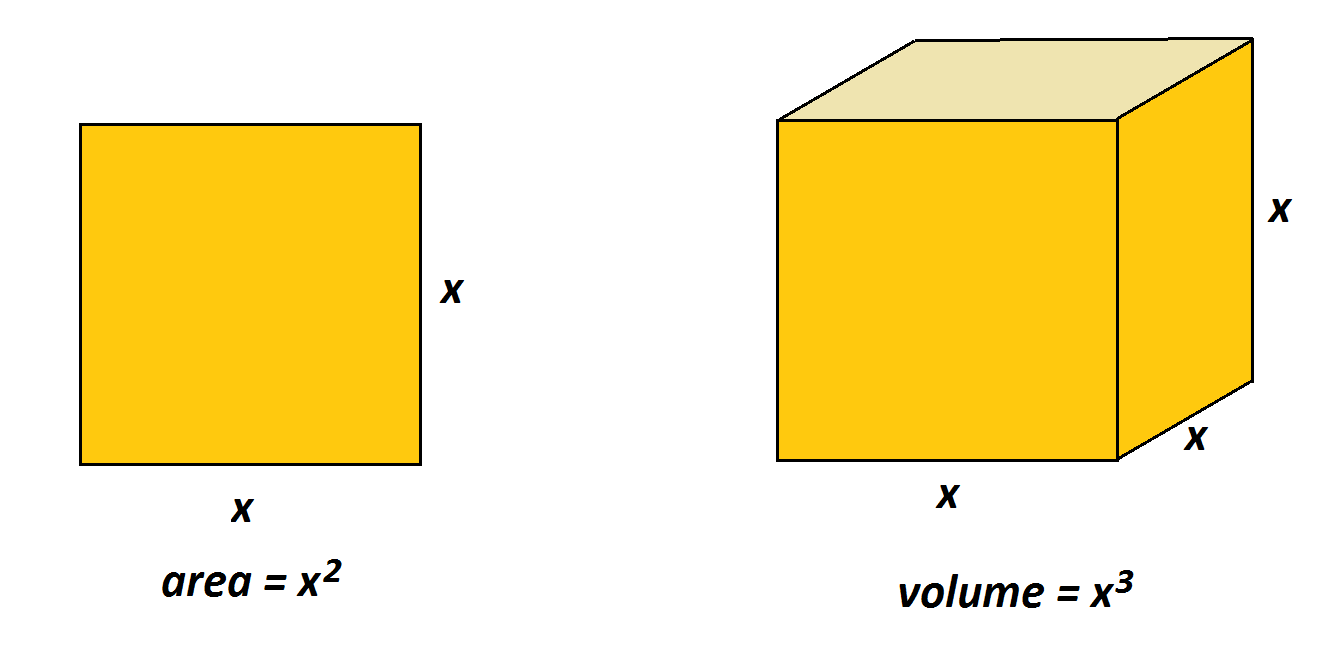
Question: Why don’t we have special language for \(x^{4}\), \(x^{5}\), and so on?
Exercise: Five students were asked to write down a formula for the area \(A\) between two squares with dimensions as shown:
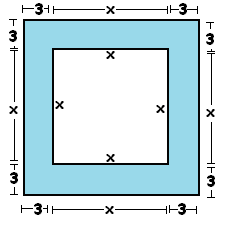
Albert thought of this shaded region as the union of four \(3\times3\) squares and four \(3\times x\) rectangles. Thus he was compelled to write \(A=36+12x\).
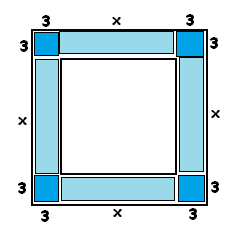
a) Bilbert wrote \(A=\left(x+6\right)^{2}-x^{2}\). How was he viewing the figure to be led to this formula ?
b) Cuthbert wrote \(A=4\times3\left(x+3\right)\). What was he seeing that led him to write this formula ?
c) Dilbert wrote \(A=4\cdot3\left(x+6\right)-4\cdot9\). What did he visualize to see this formula as the natural answer to the problem?
d) Egbert wrote \(A=2\times 3\left(x+6\right)+2 \times 3x\). What did Egbert see to lead him to this expression?
e) Show that all five expressions are algebraically equivalent.
f) A cube of side length \(x\) units sits inside a cube of side length \(x+6\). The centers of the two cubes coincide. Write down a number of different expressions for the volume of the space between the two cubes.
SQUARE ROOTS
What do you think is the root feature of a square of area \(9\) square units? Its side length, which is \(3\).
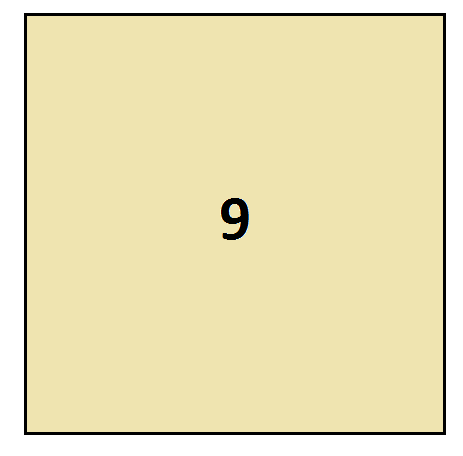
We call \(3\) the square root of \(9\) and write \(\sqrt{9}=3\).
Thus the square root of a number \(A\) is a concept from geometry – it is the side length of a square with area \(A\). And in classical geometry, all areas and side lengths are positive quantities. Thus it has become the tradition to use the symbol \(\sqrt{}\) only in the context of classical geometry.
Comment: It is true in arithmetic that there are two numbers, \(3\) and \(-3\), which, when squared, both give the answer \(9\). Thus, in the context of arithmetic, the equation \(x^{2}=9\) has two solutions: \(x=3\) and \(x=-3\). However, we are not permitted to write \(\sqrt{9}=\pm 3\). By using the \(\sqrt{\cdot}\) symbol, you are stating to the reader that we are working solely in the context of classical geometry, in which case the negative quantity is not permitted. We can only write \(\sqrt{9}=3\).
There is one exception: A square of no area has no side. Classical geometers permit writing \(\sqrt{0}=0\).
Question: Writing \(\sqrt{-9}\) is also not permitted in the context of classical geometry. (In the context of geometry, all quantities must be non-negative.) \(\sqrt{-9}\) is arithmetically meaningless too. Explain why there is no real quantity, positive or negative, whose square is \(-9\).
Exercise: Many students are tempted to write \(\sqrt{a+b}=\sqrt{a}+\sqrt{b}\).
a) Choose \(a=9\), \(b=16\). What is the value of \(\sqrt{a+b}\)? What is the value of \(\sqrt{a}+\sqrt{b}\)?
b) Find a pair of values \(a\) and \(b\) for which, by coincidence, \(\sqrt{a+b}=\sqrt{a}+\sqrt{b}\) happens to hold.
c) Describe the set of all values \(a\) and \(b\) that happen to make \(\sqrt{a+b}=\sqrt{a}+\sqrt{b}\) a true statement.
d) What is the value \(x\) of in the diagram below? (Here \(a\) and \(b\) are positive numbers.)
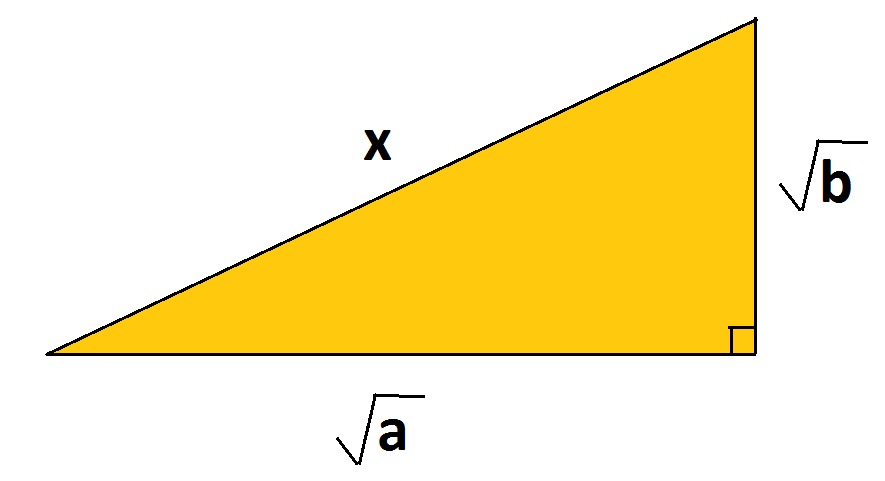
e) Explain why \(\sqrt{a+b}\) is always strictly smaller than \(\sqrt{a}+\sqrt{b}\) for positive numbers \(a\) and \(b\).
Exercise: Write \(\sqrt{3+\sqrt{8}}\) in the form \(a+\sqrt{b}\) for some integers \(a\) and \(b\).
CUBE ROOTS
What is the root feature of a cube of volume \(64\) units cubed? Its side length, which is \(4\).
We write \(\sqrt[3]{64}=4\).
In classical geometry one only ever permits positive values for volumes and side lengths (and perhaps zero values too), but mathematicians allow an exception to this tradition when it comes to cube roots. They will write \(\sqrt[3]{-1}=-1\), for example. They permit this as every real number \(N\), positive, negative, or zero, has a unique real number \(x\) associated with it such that \(x^{3}=N\). (This change of convention is rightly confusing to students!)
Exercise: What is \(\sqrt[3]{-0.008}\)?
Resources
Books
Take your understanding to the next level with easy to understand books by James Tanton.
BROWSE BOOKS![]()
Guides & Solutions
Dive deeper into key topics through detailed, easy to follow guides and solution sets.
BROWSE GUIDES![]()
Donations
Consider supporting G'Day Math! with a donation, of any amount.
Your support is so much appreciated and enables the continued creation of great course content. Thanks!
Ready to Help?
Donations can be made via PayPal and major credit cards. A PayPal account is not required. Many thanks!
DONATE![]()


